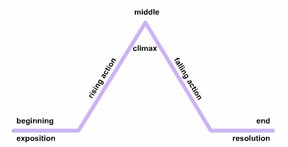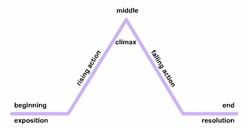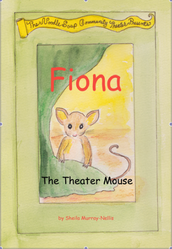There are many things in life that have stages to them, and one of them is the plot of a story. If you want to write a compelling, well-thought out story that has organization and can spark the interest of your readers, then you must understand the plot of a story. So, what exactly is plot? Plot is the events that make up your story and their relations in a sequence of cause and effect. Basically, it is the happenings of the story when conflict is introduced to your characters.

The Stages of a Story
by WordGirl26
Are you ready to write a short story, novel, or play? Find out the main stages that every story should have for a complete, well-planned plot.
THE PLOT: Beginning, middle, and end
- I'm certain that most people who has taken an English class in school or college is probably familiar with the following plot triangle diagram below.

Well, this very chart is the same thing that can help you write out the plot in your own story. I know, you probably already know this, but there are hidden secrets that some beginner writers might not be aware of and that's why I'm sharing this information. So, what should every story have?
Every story should have a beginning, middle, and end. To do this, there are five important stages that are needed to have a complete plot. These include: the exposition. the rising action, the climax, the falling action, and the resolution.
Let's start with the exposition!
THE FIRST STAGE: EXPOSITION
The Exposition ( known as the beginning of your story) is the introduction to your readers, and usually includes at least one of the following:
- The protagonist or (the main character) is introduced, or any significant character of the story.
- The problem of the story is introduced, whether internal or external. It is what your protagonist wants, or is fighting for.
- The story world is introduced. This can range from the physical setting, to the temporal setting, to the ordinary world of your protagonist, meaning their lifestyle or their insight on the world around them.
- Foreshadowing, which is the foretelling of something that is to come later in the story, such as the death of a character. A good example of this is The Lovely Bones by Alice Sebold, which is a novel written in first-person and begins with a young girl who was killed, telling the reader she was murdered before the incident occurred.
- Character backstories (history of the protagonist's past), possibly how he or she got in the situation they find themselves in in the present. For example, in the first chapter of my novel More Precious than Rubies, my character Marcus Gooding, an 18-year-old high school drop-out, looks back on his life when he was a member of a street gang and how it has affected him and his parents' relationship.
THE SECOND STAGE: RISING ACTION
Rising action is the second stage of plot and is the complications of the problem, which helps to build up the suspense of the story. This is particularly used when writing a mystery, but is important to have for any story to keep your readers wanting to know more.
It also informs:
-
Why your readers should care about your characters?
THE THIRD STAGE: CLIMAX
Climax is the third stage of plot and is the highest peak and turning point of the story when your character has reached the limit. It is where the most dramatic energy takes place in the story and can be a crisis or breaking point. For example, a woman who has been abused by her husband for years who finally thinks, 'Enough is enough' and reaches the courage to stand up to her bullying husband and leave him, either that or she kills the jerk. :p LOL.
THE FOURTH STAGE: FALLING ACTION
The Falling action is the fourth stage of the story and is how the character tries to resolve the situation after the climax has occurred. It is where the strings are being pulled together, heading toward a final finish. Let's say someone got wrongfully thrown in jail after being convicted for a homicide. Well, the falling action could be he or she trying to break out of prison.
And finally, there's....
THE FIFTH STAGE: THE RESOLUTION
The Resolution is the ending of the story. It is how the character either solves the problem or doesn't solve the problem. It can also include and explanation of the plotline, such as how a detective solved a mystery case, giving the ends and outs of how a crime was committed and what the suspects motives were.
And there you have it, the stages of a story. With theses steps you can create an organized plot that makes plenty of sense and keep your readers wanting to turn the page.
THE NEXT POST: TYPES OF CHARACTERS. What is a lead character? What is a supporting character? And how do characters differ based on these labels? Stay tuned to find out more. 😉
You might also like
How to Self Publish a Children's BookDeciding to self publish a children's book may seem simple, but there are man...



 How to Write Realistic Character Dialogueon 10/07/2014
How to Write Realistic Character Dialogueon 10/07/2014
 Characterization: Setting is a character tooon 09/22/2014
Characterization: Setting is a character tooon 09/22/2014
 Characterization: Character Emotionon 09/18/2014
Characterization: Character Emotionon 09/18/2014
 Characterization: Types of Characterson 09/15/2014
Characterization: Types of Characterson 09/15/2014

Comments
To CsMcClellan: I didn't say people *HAVE* to use this plan to write their own stories, this post was just a simple explanation of the flow of a story in general. Sorry, didn't mean to offend. ;)
Not all stories or novels follow this plan, and it's misleading to assert that this is how they *have* to be written.
Very succinct without skipping important points.